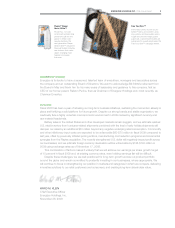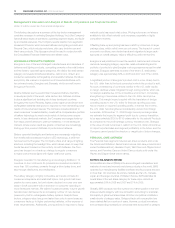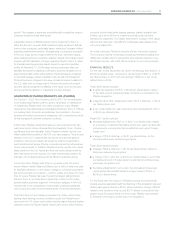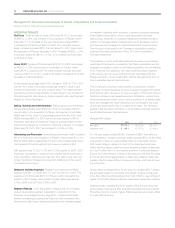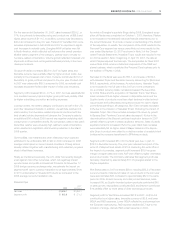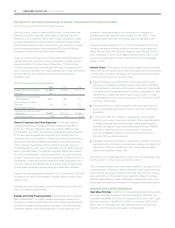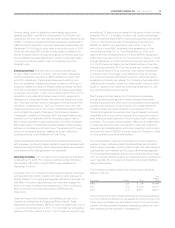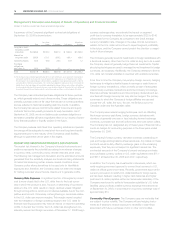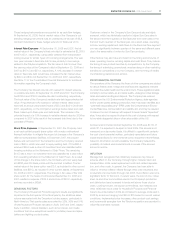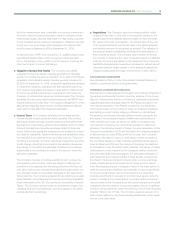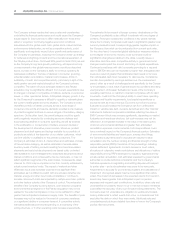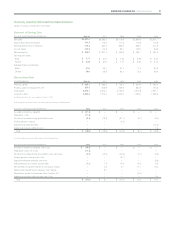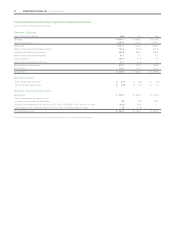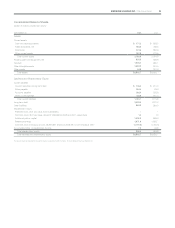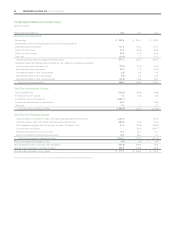Energizer 2008 Annual Report Download - page 21
Download and view the complete annual report
Please find page 21 of the 2008 Energizer annual report below. You can navigate through the pages in the report by either clicking on the pages listed below, or by using the keyword search tool below to find specific information within the annual report.
ENERGIZER HOLDINGS, INC. 2008 Annual Report 19
As of the measurement date, uncertainty in economic markets and
the credit crisis produced an increase in yields in corporate bonds
rated as high-quality. Discount rates based on high-quality corporate
bonds increased as well, leading to decreases in obligations reported
at year end. A one percentage point decrease in the discount rate
would increase obligations by $65 at September 30, 2008.
As allowed under GAAP, the Company’s U.S. qualified pension plan
uses Market Related Value, which recognizes market apprecia-
tion or depreciation in the portfolio over five years so it reduces the
short-term impact of market fluctuations.
■ Valuation of Long-Lived Assets The Company periodically
evaluates its long-lived assets, including goodwill and intangible
assets, for potential impairment indicators. As a result of the Playtex
acquisition, total intangible assets, including goodwill, increased to
$2,869.6 at September 30, 2008. Judgments regarding the existence
of impairment indicators, including lower than expected cash flows
from acquired businesses, are based on legal factors, market condi-
tions and operational performance. Future events could cause the
Company to conclude that impairment indicators exist. The Company
estimates fair value using valuation techniques such as EBITDA mul-
tiples and discounted cash flows. This requires management to make
assumptions regarding future income, working capital and discount
rates, which would affect the impairment calculation.
■ Income Taxes The Company estimates income taxes and the
income tax rate in each jurisdiction that it operates. This involves
estimating taxable earnings, specific taxable and deductible items,
the likelihood of generating sufficient future taxable income to utilize
deferred tax assets and possible exposures related to future tax
audits. Deferred tax assets are evaluated on a subsidiary by subsid-
iary basis for realizability. Valuation allowances are established when
the realization is not deemed to be more likely than not. Future per-
formance is monitored, and when objectively measurable operating
trends change, adjustments are made to the valuation allowances
accordingly. To the extent the estimates described above change,
adjustments to income taxes are made in the period in which the
estimate is changed.
The Company operates in multiple jurisdictions with complex tax
and regulatory environments, which are subject to differing inter-
pretations by the taxpayer and the taxing authorities. At times, we
may take positions that management believes are supportable, but
are potentially subject to successful challenges by the appropriate
taxing authority. The Company evaluates its tax positions and estab-
lishes liabilities in accordance with Financial Accounting Standards
Board Interpretation No. 48, “Accounting for Uncertainty in Income
Taxes.” The Company reviews these tax uncertainties in light of the
changing facts and circumstances, such as progress of tax audits,
and adjusts them accordingly.
■ Acquisitions The Company uses the purchase method, which
requires the allocation of the cost of an acquired business to the
assets acquired and liabilities assumed based on their estimated
fair values at the date of acquisition. The excess value of the cost
of an acquired business over the fair value of the assets acquired
and liabilities assumed is recognized as goodwill. The valuation of
the acquired assets and liabilities will impact the determination of
future operating results. The Company uses a variety of informa-
tion sources to determine the value of acquired assets and liabilities
including: third-party appraisers for the values and lives of property,
identifiable intangibles and inventories; actuaries for defined benefit
retirement plans and legal counsel or other experts to assess the
obligations associated with legal, environmental or other claims.
ACCOUNTING STANDARDS
See discussion in Note 2 to the Consolidated Financial Statements
related to recently issued accounting standards.
FORWARD-LOOKING INFORMATION
Statements in the Management’s Discussion and Analysis of Results of
Operations and Financial Condition and other sections of this Annual
Report to Shareholders that are not historical, particularly statements
regarding estimated synergies related to the Playtex acquisition; the
international expansion of the Playtex product line; the anticipated
continuing success of the Company’s trade-up strategy for batteries
and lighting products; battery category softness on a global basis;
the existence and impact of excess battery inventory going into the
first quarter; the anticipated impact of inflationary commodity and
other material input costs, as well as our ability to increase prices,
cost reduction programs and incremental synergies to offset such
increases; the estimated impact of foreign currency devaluation on the
Company’s profitability in 2009 and the likelihood of attaining targeted
or flat earnings per share (EPS) growth for the year; the Company’s
estimates of its share of total U.S. retail battery market and share of
the wet shave category in major markets; estimated capital expendi-
tures for fiscal year 2009 and their source of financing; the likelihood
of acceleration of the Company’s debt maturities, the impact of further
deterioration in credit markets on the Company’s ability to renew its
accounts receivable financing program, the anticipated adequacy of
cash flows and the Company’s ability to meet liquidity requirements;
the impact of adverse changes in interest rates, currency exchange
losses in Venezuela and the market risk of foreign currency deriva-
tives; the mitigating impact of changes in value of the share option on
deferred compensation liabilities; the materiality of future expenditures
for environmental matters and environmental control equipment;
potential adjustments to accruals for promotional program costs; the
impact of variations from assumptions on pension asset returns and
discount rates on the Company’s pre-tax pension expense and benefit
obligations; and the valuation of long-lived assets, may be considered
forward-looking statements within the meaning of the Private Securities
Litigation Reform Act of 1995. The Company cautions readers not to
place undue reliance on any forward-looking statements, which speak
only as of the date made.


